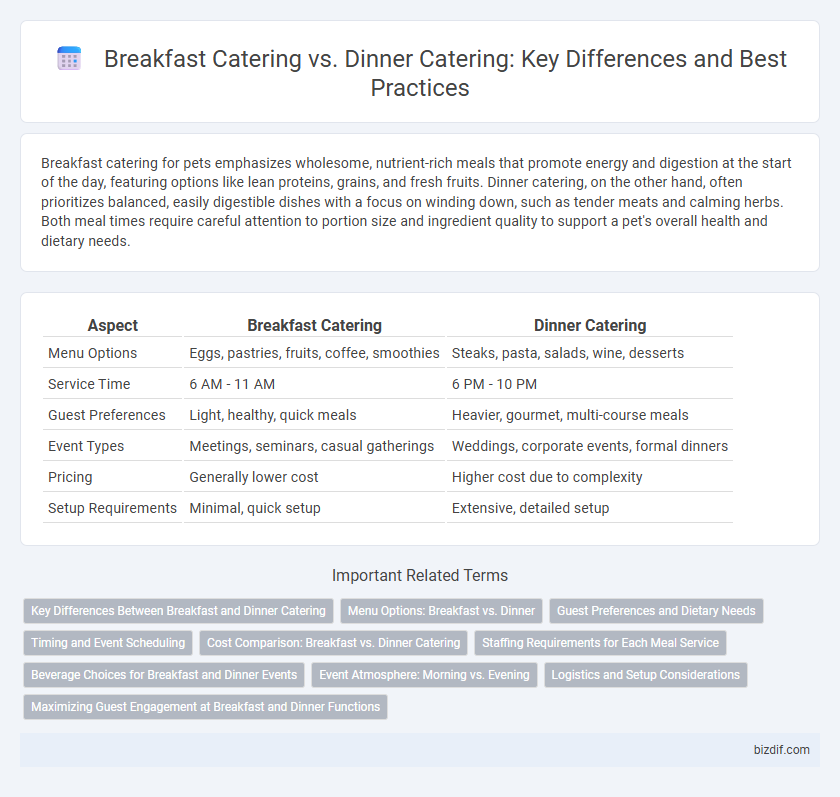Breakfast catering for pets emphasizes wholesome, nutrient-rich meals that promote energy and digestion at the start of the day, featuring options like lean proteins, grains, and fresh fruits. Dinner catering, on the other hand, often prioritizes balanced, easily digestible dishes with a focus on winding down, such as tender meats and calming herbs. Both meal times require careful attention to portion size and ingredient quality to support a pet's overall health and dietary needs.
Table of Comparison
| Aspect | Breakfast Catering | Dinner Catering |
|---|---|---|
| Menu Options | Eggs, pastries, fruits, coffee, smoothies | Steaks, pasta, salads, wine, desserts |
| Service Time | 6 AM - 11 AM | 6 PM - 10 PM |
| Guest Preferences | Light, healthy, quick meals | Heavier, gourmet, multi-course meals |
| Event Types | Meetings, seminars, casual gatherings | Weddings, corporate events, formal dinners |
| Pricing | Generally lower cost | Higher cost due to complexity |
| Setup Requirements | Minimal, quick setup | Extensive, detailed setup |
Key Differences Between Breakfast and Dinner Catering
Breakfast catering typically features lighter, quick-serve options such as pastries, fruit, eggs, and coffee, designed for early hours and energizing guests. Dinner catering emphasizes more elaborate, multi-course menus including proteins like beef or fish, rich sides, and wine pairings, catering to a formal or social evening setting. Service style and meal complexity vary significantly, with breakfast often being buffet or grab-and-go, while dinner usually involves plated service or stations with a focus on presentation and ambiance.
Menu Options: Breakfast vs. Dinner
Breakfast catering offers a variety of menu options including pastries, eggs, bacon, fresh fruit, yogurt, and granola, emphasizing lighter, energy-boosting foods suitable for morning events. Dinner catering tends to feature more substantial dishes such as roasted meats, pasta, seafood, and rich appetizers designed for a formal or hearty meal experience. Both breakfast and dinner menus can be customized to accommodate dietary preferences, but dinner catering usually includes a wider range of courses and more complex flavors.
Guest Preferences and Dietary Needs
Breakfast catering often prioritizes lighter, energizing options such as fresh fruit, yogurt, and whole grains to accommodate guests seeking a nutritious start to their day. Dinner catering typically includes more diverse and hearty selections, catering to varied dietary preferences like gluten-free, vegan, or low-carb options to satisfy complex guest demands. Understanding these differences ensures tailored menus that enhance guest satisfaction and accommodate specific dietary restrictions effectively.
Timing and Event Scheduling
Breakfast catering typically requires early morning preparation and prompt service to accommodate start-of-day meetings and events, often between 7 AM and 10 AM. Dinner catering involves more flexible scheduling but demands coordination for later hours, usually starting from 6 PM onwards, aligning with formal dinners or evening functions. Efficient timing and event scheduling are crucial in both to ensure food quality and seamless guest experience.
Cost Comparison: Breakfast vs. Dinner Catering
Breakfast catering generally costs less than dinner catering due to lower ingredient and preparation expenses, often featuring simpler dishes like pastries, eggs, and coffee. Dinner catering typically involves more complex menus with multiple courses, premium proteins, and beverages, which increase the overall price. Event size, service style, and location also influence cost, but breakfast catering remains the more budget-friendly choice for most occasions.
Staffing Requirements for Each Meal Service
Breakfast catering typically demands fewer staff due to simpler menu items and quicker service times, often requiring only servers and a chef. Dinner catering usually involves more complex dishes and extended service, necessitating additional kitchen staff, waiters, and event coordinators to manage multi-course meals and guest needs. Staffing ratios for dinner service are generally higher to ensure smooth service flow and a premium dining experience.
Beverage Choices for Breakfast and Dinner Events
Breakfast catering often emphasizes coffee, tea, fresh juices, and smoothies to provide energizing and refreshing beverage options that complement morning meals. Dinner catering typically features a wider range of beverage choices, including wine, cocktails, craft beers, and non-alcoholic mocktails to enhance the evening dining experience. Tailoring beverage selections to suit the time of day and menu style is essential for creating a cohesive and satisfying event.
Event Atmosphere: Morning vs. Evening
Breakfast catering creates a bright and energetic event atmosphere, often characterized by natural daylight and a fresh start vibe, promoting social interaction and productivity. Dinner catering sets a more intimate and elegant tone, with dimmed lighting and a relaxed ambiance that encourages leisurely conversation and celebration. The choice between morning and evening catering significantly impacts guest mood, venue decoration, and menu style to align with the desired event experience.
Logistics and Setup Considerations
Breakfast catering often requires early arrival times and efficient setup to ensure food freshness and timely service, especially for events starting early in the day. Dinner catering generally involves more complex logistics, including extensive menu options, beverage service, and ambient lighting adjustments to create an inviting atmosphere. Both setups demand attention to equipment needs, staff coordination, and space allocation to optimize guest experience and operational flow.
Maximizing Guest Engagement at Breakfast and Dinner Functions
Breakfast catering often emphasizes fresh, energizing options like fruit, yogurt, and gourmet coffee to stimulate guests' senses and encourage early social interaction. Dinner catering focuses on rich, multi-course meals paired with wine or cocktails that create an inviting atmosphere for deeper conversations and prolonged engagement. Tailoring menu selections and service styles according to the mealtime can significantly enhance guest satisfaction and participation.
Breakfast catering vs Dinner catering Infographic

 bizdif.com
bizdif.com